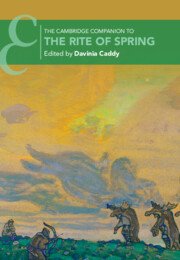Refine search
Actions for selected content:
3 results
4 - Movement and Choreographic Influence: The Contribution of Vaslav Nijinsky to The Rite of Spring
- from Part I - The Paris Premiere
-
-
- Book:
- The Cambridge Companion to <i>The Rite of Spring</i>
- Published online:
- 28 June 2025
- Print publication:
- 17 July 2025, pp 74-100
-
- Chapter
- Export citation
6 - Framing Modernism: Primitivism, Grotesquerie and Orientalism in French Art and Visual Culture
- from Part II - Contexts
-
-
- Book:
- The Cambridge Companion to <i>The Rite of Spring</i>
- Published online:
- 28 June 2025
- Print publication:
- 17 July 2025, pp 125-146
-
- Chapter
- Export citation

The Cambridge Companion to The Rite of Spring
-
- Published online:
- 28 June 2025
- Print publication:
- 17 July 2025
